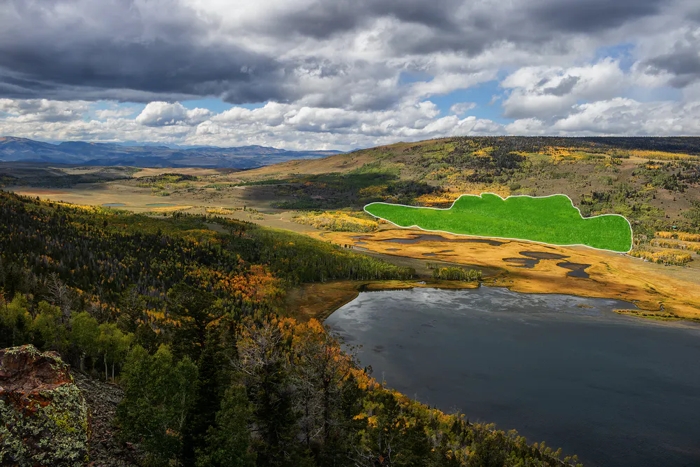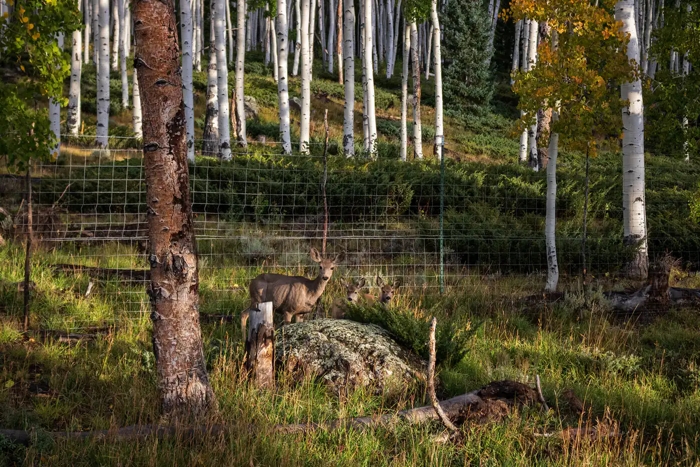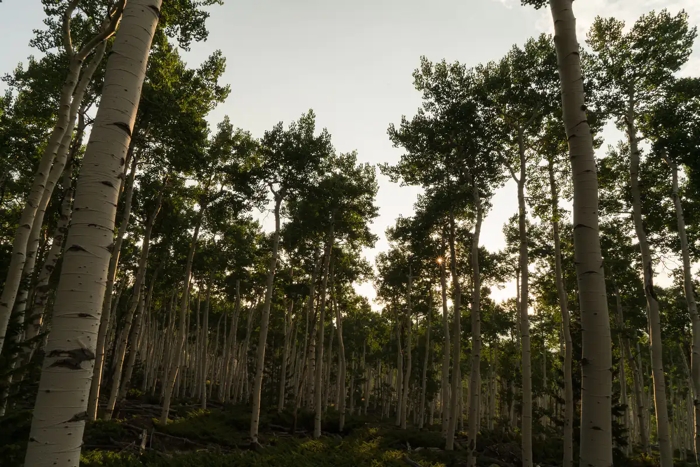In the Wasatch Mountains of the western US, on the slopes above a spring-fed lake, lives one giant organism that forms an entire ecosystem that plants and animals have relied on for thousands of years.
Found in my home state of Utah, “Pando” is a 106-acre stand of quaking aspen clones.
Although it looks like a forest of individual trees with distinctive white bark and small leaves that flutter with the slightest breeze, Pando (Latin for ‘I spread’) is actually made up of 47,000 genetically identical stems that arise from an interconnected root network.
This single genetic individual weighs approximately 6,000 tons. By mass it is the largest organism on Earth.
 Aerial view of Pando, with Fish Lake in the foreground. (Lance Oditt/Friends of Pando)
Aerial view of Pando, with Fish Lake in the foreground. (Lance Oditt/Friends of Pando)
Aspen trees tend to form clonal stands elsewhere, but what makes Pando interesting is its sheer size. Most clonal aspen stands in North America are much smaller, while those in the western US average only 3 hectares in size.
Pando has been around for thousands of years, possibly as long as 14,000 years, despite most tribes being only about 130 years old. Its longevity and remoteness mean that an entire ecosystem of 68 plant species and many animals have developed and supported in the shade.
This entire ecosystem depends on the aspen staying healthy and upright. But while Pando is protected by the U.S. National Forest Service and is not in danger of being logged, it is in danger of disappearing due to several other factors.
Deer eat the youngest ‘trees’
Overgrazing by deer and elk is one of the biggest concerns. Wolves and cougars once kept their numbers in check, but the herds are now much larger due to the loss of these predators.
Deer and elk also often congregate in Pando, as the protection the forest receives ensures that they are not hunted.
 Deer eating Pando shoots. (Lance Oditt/Friends of Pando)
Deer eating Pando shoots. (Lance Oditt/Friends of Pando)
As older trees die or fall, light reaches the forest floor, stimulating new clonal stems to grow. But when these animals eat the tips of newly formed stems, they die. This means that there is little new growth in large parts of Pando.
The exception is an area that was fenced several decades ago to remove dying trees. This fenced area has excluded elk and deer and has seen successful regeneration of new clonal stems, with a dense vegetation called the “bamboo garden”.
Diseases and changing climate
Older stems in Pando are also affected by at least three diseases: sooty bark canker, leaf spot and conk fungus.
Although plant diseases have developed and thrived in aspen areas for thousands of years, it is unknown what the long-term effect on the ecosystem may be, as there is a lack of new growth and an ever-growing list of other pressures on the clonal giant . .
The fastest growing threat is climate change. Pando formed after the last ice age ended and has experienced a largely stable climate since then.
 Pando has survived diseases, hunting and colonization. (Lance Oditt/Friends of Pando)
Pando has survived diseases, hunting and colonization. (Lance Oditt/Friends of Pando)
To be fair, it lives in a desert-surrounded mountain area, meaning it is no stranger to warm temperatures or drought. But climate change threatens the tree’s size and longevity, as well as the entire ecosystem it hosts.
Although no scientific studies have focused specifically on Pando, aspen populations are facing pressures related to climate change, such as reduced water supplies and warmer weather earlier this year, making it harder for trees to form new leaves, which has led to declines . in terms of coverage.
With increased competition for ever-dwindling water supplies (nearby Fish Lake is just beyond the reach of the tree’s root system), temperatures expected to continue to soar to record highs in the summer, and the threat of even more intense wildfires, Pando is sure to struggle to adapt to these rapidly changing conditions while maintaining their scale.
The next 14,000 years
Yet Pando is resilient and has already survived rapid environmental changes, especially when European settlers began inhabiting the area in the 19th century or after the rise of recreational activities in the 20th century. It has faced disease, forest fires and grazing before and remains the largest scientifically documented organism in the world.
Despite all the cause for concern, there is hope as scientists help us unlock the secrets of Pando’s resilience, while conservation groups and the U.S. Forest Service work to protect this tree and its ecosystem. And a group called the Friends of Pando wants to make the tree accessible to almost everyone through 360 video recordings.
While visiting my family in Utah one summer, I took the opportunity to visit Pando. I spent two wonderful days walking beneath towering mature stems that sway and “tremble” in the gentle breeze, among the thick new growth in the “bamboo garden,” and even in charming meadows that puncture parts of the otherwise enclosed downtown area.
I marveled at the wildflowers and other plants that thrived under the dappled shade canopy, and enjoyed spotting pollinating insects, birds, foxes, beavers and deer, all utilizing part of the ecosystem created by Pando.
It’s these moments that remind us that we have plants, animals and ecosystems worth protecting. In Pando we get the rare opportunity to protect all three.![]()
Richard Elton Walton, Postdoctoral Research Fellow in Biology, University of Newcastle.
This article is republished from The Conversation under a Creative Commons license. Read the original article.
An earlier version of this article appeared in November 2021.



